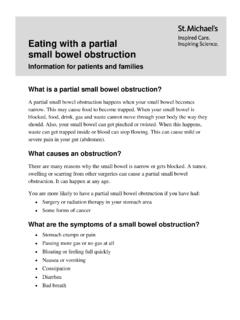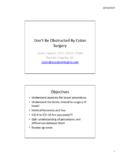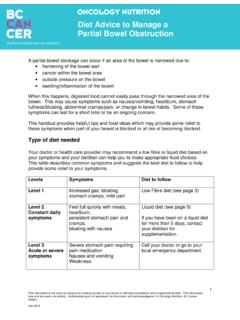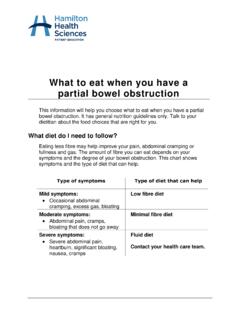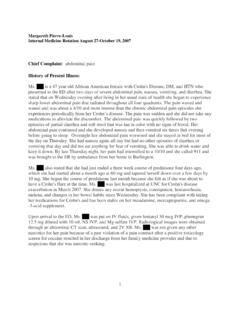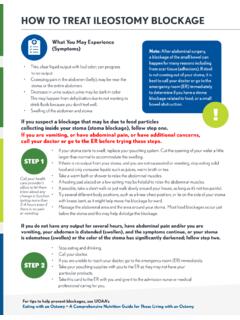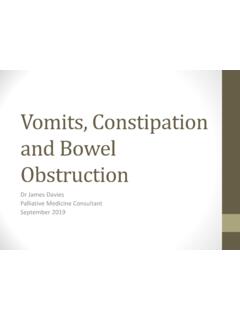Transcription of Symptom Management Guidelines: CONSTIPATION
1 Symptom Management Guidelines: CONSTIPATION Definition(s) CONSTIPATION : A subjective experience of an unsatisfactory defecation characterized by infrequent stools and/or difficult stool passage ( straining, incomplete evacuation, hard/lumpy stools, prolonged time to pass stool, need for manual maneuvers) Contributing Factors Chemotherapy Agents Vinca alkaloids ( vincristine, vinblastine, vinorelbine) Platinums ( carboplatin, oxaliplatin) Taxanes ( paclitaxel) Thalidomide Medications Opioids Vitamin Supplements ( calcium and iron) Antiemetics ( 5-HT3 antagonists- ondansetron, granisetron) Drugs with anticholinergic effects ( antidepressants, antihistamines, antiparkinsonisms) Antispasmodics, anticonvulsants, phenothiazines Antacids that contain aluminum and calcium Diuretics Relevant Medical History Metabolic disturbances - Electrolyte imbalances ( hypercalemia, hyponatremia, hypokalemia) - Hypothyroidism - Uremia - Diabetes Neurological disturbances - Spinal cord involvement ( compression and injuries) - Sacral nerve infiltration - Autonomic dysfunction Structural Abnormalities - Narrowing of bowel lumen-tumor compression, radiation fibrosis/scarring, surgical anastomosis Bowel Disturbances Bowel disorders ( irritable bowel syndrome, diverticulitis)
2 Altered bowel habits - ignore urge to defecate Pain associated with defecation Diet and Activity Diet- reduced food and fiber intake Dehydration Decreased physical activity and mobility Other Advanced age Advanced illness Altered cognition, sedation Consequences Fecal impaction, overflow diarrhea (+/- incontinence) Hemorrhoids, rectal tearing, fissures, or prolapse Complete or partial bowel obstruction , bowel perforation Infection, sepsis Excessive straining contributing to syncope, cardiac arrhythmias Impaired absorption of oral medications The information contained in these documents is a statement of consensus of BC Cancer Agency professionals regarding their views of currently accepted approaches to treatment. Any clinician seeking to apply or consult these documents is expected to use independent medical judgement in the context of individual clinical circumstances to determine any patient's care or treatment.
3 Use of these documents is at your own risk and is subject to BC Cancer Agency's terms of use, available at Page 1 of 6 Focused Health Assessment GENERAL ASSESSMENT Symptom ASSESSMENT PHYSICAL ASSESSMENT Contact and General Information Physician name - oncologist, family physician Pharmacy Home health care Other healthcare providers Allergies Consider Contributing Factors Cancer diagnosis Cancer treatment(s) note type and date of last treatment(s), concurrent treatments Medical history Medication profile Recent lab, diagnostic reports Opioids Dehydration Reduced food and fiber intake Normal What are your normal bowel habits? Explore patient s definition of CONSTIPATION Onset When did change in bowel habits begin?
4 When was your last bowel movement? When was your bowel movement prior to this one? Provoking / Palliating What makes the stools harder/softer, watery, more/or less frequent? What has your diet been like? What are you drinking? Eating? How much? Quality Describe your last bowel movement amount, consistency, colour Passing flatus? Straining required to pass stool? Region / Radiation N/A Severity / Other Symptoms How bothered are you by this Symptom ? (on a scale of 0 10, with 0 being not at all to 10 being the worst imaginable) Have you been experiencing any: - Abdominal distention, cramping, severe pain, nausea or vomiting possible bowel obstruction - Sensory loss, +/- motor weakness, urinary changes possible spinal cord compression - Diarrhea accompanying CONSTIPATION possible overflow around fecal impaction - Rectal bleeding or pain - Loss of appetite Treatment What medications or treatments have you tried?
5 Has this been effective? (check to see if patient has been prescribed a bowel Management protocol. If so, what step?) Have you had any previous impactions since your diagnosis? Understanding / Impact on You Have your symptoms been interfering with your normal daily activity (ADLs)? Value What do you believe is causing your CONSTIPATION ? Abdominal Assessment Auscultate abdomen - assess presence and quality of bowel sounds Abdominal pain, tenderness, distention Palpable fecal masses Digital Rectal Exam (DRE) Do NOT perform DRE if patient has neutropenia or low platelet count Place in left, lateral recumbent position Assess for: - Hemorrhoids, fissures, abscesses - Hard impacted stool of tumor mass Hydration Status Assess mucous membranes, skin turgor, capillary refill, amount and character of urine Weight Take current weight and compare to pre treatment or last recorded weight Vital Signs Include as clinically indicated The information contained in these documents is a statement of consensus of BC Cancer Agency professionals regarding their views of currently accepted approaches to treatment.
6 Any clinician seeking to apply or consult these documents is expected to use independent medical judgement in the context of individual clinical circumstances to determine any patient's care or treatment. Use of these documents is at your own risk and is subject to BC Cancer Agency's terms of use, available at Page 2 of 6 CONSTIPATION GRADING SCALE* NCI Common Terminology Criteria for Adverse Events (Version ) GRADE 1 (Mild) GRADE 2 (Moderate) GRADE 3 (Severe) GRADE 4 (Life - threatening) GRADE 5 Occasional or intermittent symptoms; occasional use of stool softeners, laxatives, dietary modification, or enema Persistent symptoms with regular use of laxatives or enemas; limiting instrumental ADLs ( preparing meals, shopping, managing money) Obstipation with manual evacuation indicated; limiting self-care ADL ( bathing, dressing, feeding self, using the toilet, taking medications) Life-threatening consequences.
7 Urgent intervention indicated Death *A semi-colon indicates or within the description of the grade and a single dash (-) indicates a grade is not available *Step-Up Approach to Symptom Management : Interventions Should Be Based On Current Grade Level and Include Lower Level Grade Interventions As Appropriate GRADE 1 GRADE 2 NON URGENT: Prevention, support, teaching, and follow-up as clinically indicated Patient Care and Assessment Assess pattern (number of days since last stool), characteristic of stool (solid/hard/pellet) and degree of effort/straining required to defecate (minimal/moderate/major or unable to defecate despite maximal effort/strain) Assessment and Management of contributing factors. If opioid related, See opioid-induced CONSTIPATION : Special Considerations below * Avoid suppositories, enemas, disimpaction, or rectal exams if patient neutropenic or has low platelets Pharmacological Management Use a step up approach according to bowel protocol to ensure regular bowel movements See BCCA Bowel Protocols in Resources Section below Appendix A: Pharmacological Agents that may be used to Manage CONSTIPATION below Bowel Routine Encourage.
8 Attempts to defecate 30-60 minutes after meals to take advantage of gastrocolic reflex Prompt response to the urge to defecate Privacy and uninterrupted time when toileting Sitt ing or squatting position, consider raised toilet seats or commodes Adequate pain control for optimal bowel movement and comfort Monitor and record bowel movements for pattern, characteristic and degree of effort/strain Avoid: Excessive straining Physical Activity and Dietary Management Physical Activity: Promote regularly physical activity and mobilization as appropriate Fluid Intake: Encourage 8 12 cups of fluids throughout the day to maintain normal bowel habits Caution in patients with comorbidities that affect fluid balance ( Congestive heart failure) - Encourage a warm drink before usual time of defecation - Limit caffeine consumption (coffee 1-2 cups a day, black tea 4-5 cups a day) - Limit alcohol consumption as it can contribute to fluid loss The information contained in these documents is a statement of consensus of BC Cancer Agency professionals regarding their views of currently accepted approaches to treatment.
9 Any clinician seeking to apply or consult these documents is expected to use independent medical judgement in the context of individual clinical circumstances to determine any patient's care or treatment. Use of these documents is at your own risk and is subject to BC Cancer Agency's terms of use, available at Page 3 of 6 Physical Activity and Dietary Management Foods: Encourage natural laxatives ( prunes, dates) Aim for 20-35 grams of dietary fiber per day through diet or supplements Gradually increase daily fiber intake; to reduce associated symptoms of bloating and distention, ensure patient consumes at least 1500mL (6 cups) fluid per day High fiber intake is contraindicated in patients with poor fluid intake and at high risk for bowel obstruction Patient Education and Follow - up Normal bowel movements vary amongst people and can be altered by food consumption.
10 Even with minimal intake patients should still have a bowel movement Reinforce with patients when to seek immediate medical attention: - T 38 C - Severe cramping, acute onset of abdominal pain, distention (+/- nausea & vomiting) possible bowel obstruction - Sensory loss (+/- motor weakness) possible spinal cord compression - Dizziness, weakness, confusion, excessive thirst, dark urine possible dehydration - No bowel movement in 3 days may require adjustment to bowel protocol Instruct patient/family to call back in 24 hours if symptoms worsen or do not improve If indicated, arrange for nurse initiated or physician follow up See Resources & Referrals GRADE 3 AND/OR the presence of either: No bowel movement for >3 days and not responding to a bowel protocol Increasing abdominal pain & distention GRADE 4 AND/OR the presence of either: Temperature > 38oC Acute abdominal pain and distention (+/- nausea or vomiting) Sensory loss (+/- motor weakness) URGENT: Requires medical attention within 24 hours EMERGENT: Requires IMMEDIATE medical attention Patient Care and Assessment Collaborate with physician: - To rule out other causes or concomitant causes of CONSTIPATION ( bowel obstruction and spinal cord compression) See Alert Guidelines in Resources Section below - Need for further patient assessment at clinic or if patient requires hospital admission Lab and diagnostic tests that may be ordered.










